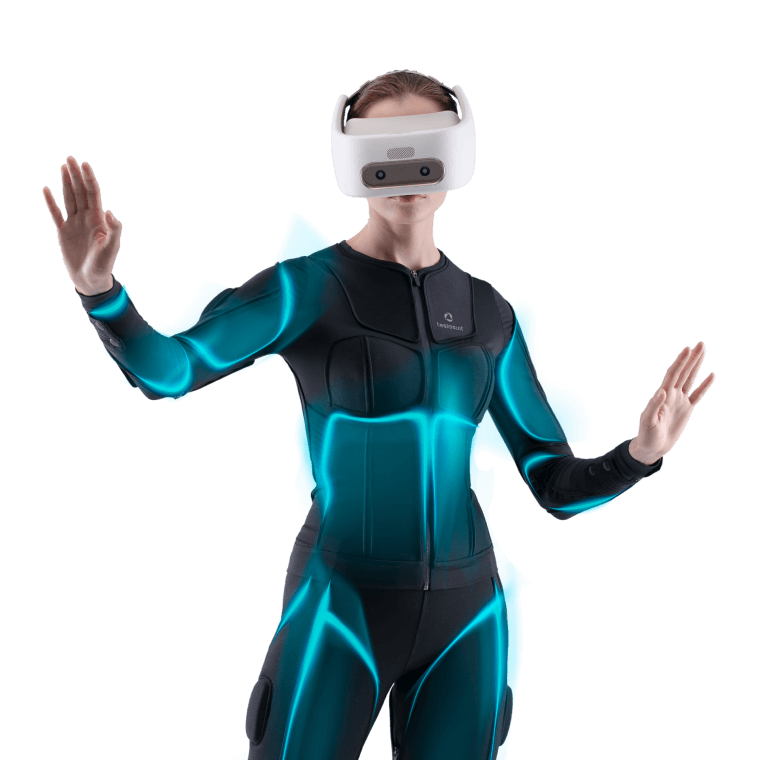a VR suit could help you ‘feel’ things in the metaverse
The full-body suit can be moved by electric signals sent to it, or it can relay them to record exactly how it is being moved by the wearer: the metaverse feels more real.
It may soon be possible to “feel” the metaverse. A team of eight mechanical engineering students at ETH Zurich, the Swiss Federal Institute of Technology, are developing a tactile suit that covers the entire body to “superboost” immersive experiences in the metaverse.
The suit features many sensors and soft, human-like muscles, allowing “a lot more natural interaction with virtual reality”.
“Metaverse suit”: what is it?
“The Meta Suit is basically a suit that is built with artificial muscles and that enables us to have greater interaction with virtual reality,” said Maximilan Eberlein, project lead at ETH Zurich. “The main idea was to incorporate new artificial muscles called Hasel [hydraulically amplified self-healing electrostatic – actuators] into a suit that enables more interaction with virtual reality,” Eberlein added.
The novel technology Hasel is critical to achieving the team’s goals. The artificial muscles feel similar to human muscles and send haptic feedback to the suit so the wearer can ‘feel’ the virtual environment.
How does it work?
The muscles contract and expand with a tiny electric current, just like a zip-lock bag. “So you have pouches that are filled with a special fluid and you spray electrodes on them and you apply a voltage on these electrodes so that these muscle zip together and this leads to a contraction of the muscle,” Eberlein explained.
The Meta Suit can also track and map the movements of humans without using any camera systems, a method called “proprioception”. Most VR devices currently use visual cues, which are expensive and don’t function at the fullest capacity when in poor lighting, said Eberlein.
The students at ETH Zurich aim to tackle these limitations of the current technology. In a test, the team has created a virtual reality where the player can let a bird land on their hand and feel it using the muscles contracting on the suit.
“It is amazing. Like, the first few tries where we actually tried our technology we all had to laugh because it was such an amazing feeling, something I’ve never felt before. You’re in an entirely other environment. You could be on Mars and you feel something and it feels real,” said Eberlein.
Market potential
Its inventors are convinced that the Meta Suit has potential use cases beyond VR, such as motion tracking systems for movies and animations and restarting “frozen gait,” a symptom of Parkinson’s that requires a prompt to help the patient move.
Similar projects
Other companies are working on similar projects: TESLASUIT’s full body haptic feedback system, for instance, uses electro muscle stimulation (EMS) and transcutaneous electrical nerve stimulation (TENS) to simulate a range of real-life feelings and sensations. Using this system, the TESLASUIT can provide physical feedback based on the visual simulation that may be experienced on a flat screen or immersive reality devices.

TESLASUIT’s motion capture system uses 14 Inertial Measurement Unit (IMU) sensors to identify specific points around the TESLASUIT to track, record and monitor the movements and positioning of users. Each IMU sensor is made up of an accelerometer, gyroscope, and magnetometer. The motion capture system can be used for animation creation (games, movies, etc.), performance monitoring and capture (sports, etc.), ergonomics and human factor testing (research, data analysis).
This can provide more immersive experiences, build muscle memory, autocorrect technique, and build deep learning environments.
TESLASUIT’s biometry system provides a deep and readable set of information aimed at understanding the physical state of the user. The photoplethysmography (PPG) system gives information about the cardiorespiratory system by calculating the user’s heart beat per minute (BPM) and pulse rate variability (PRV).
This enables interactive VR/AR training content that adapts to the trainee for personalized experiences.
At present, Teslasuit is just available for business purposes. Its price starts from $12.999.
source: Euronews.Next I Teslanews
cover image: Euronews.Next
Maker Faire Rome – The European Edition has been committed since its very first editions to make innovation accessible and usable to all, with the aim of not leaving anyone behind. Its blog is always updated and full of opportunities and inspiration for makers, makers, startups, SMEs and all the curious ones who wish to enrich their knowledge and expand their business, in Italy and abroad.
Follow us, subscribe to our newsletter: we promise to let just the right content for you to reach your inbox.



















































































